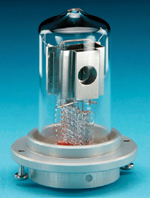CHROMSPEC™ HPLC Lamps
 CHROMSPEC™ lamps are sourced from the same manufacturers used by instrument OEMs. Lamps are pre-aligned using the same techniques specified by OEMs. All base bulbs are instrument specific for proper air circulation and temperature control. We have lamps available for the following instrument manufacturers:
CHROMSPEC™ lamps are sourced from the same manufacturers used by instrument OEMs. Lamps are pre-aligned using the same techniques specified by OEMs. All base bulbs are instrument specific for proper air circulation and temperature control. We have lamps available for the following instrument manufacturers:
|
|
|
|
|
Click here for ordering information |
What is an Application Matched Lamp?
CHROMSPEC™ brand D2 Pre-Aligned Lamps are not generic lamps mounted and aligned in a holder for a particular model of spectrophotometer or detector. Each model of CHROMPSEC™ lamp is based on a base lamp carefully matched to the lamp or lamps chosen by the OEM. As well as ensuring the lamp chosen matches with the power supply of the instrument, our lamps are also matched for construction materials, dimensions and alignment style. We have listed a few of the considerations for application matched lamps below.
Bulb Material
UV glass
- Short wavelength cut-off of 185nm
- Limits use in short wavelength analysis
- Prevents ozone production within the instrument. Eliminates need for ozone handling in instrument
- Less prone to gas leakage than synthetic silica.
Synthetic silica
- Short wavelength cut-off of 160 nm
- Much higher light transmittance below 225 nm compared to UV glass.
- Improves analysis at short wavelengths
- Instruments using these lamps must deal with the ozone generated by short wavelength UV.
- Synthetic silica is higher in purity than natural quartz, minimizing darkening of bulb by UV exposure (solarization).
Electrode Design
Arc Size
- At a given input power, the aperture of a deuterium lamp determines its light intensity.
- Two aperture sizes are typical for HPLC detector and spectrophotometer lamps.
- Older lamps and instruments use a 1mm aperture,
- More modern instruments are designed for a 0.5mm aperture.
- 0.5 mm aperture provides 50% higher light intensity compared to lamps with a 1.0 mm diameter aperture.
- Lamp alignment is more critical with a 0.5mm aperture than with a 1.0mm aperture
Operating Temperature
Deuterium lamps have a high, but relatively narrow ideal range of operating temperatures.
Long term use of bulbs either above or below their ideal temperature range shortens lifespan by damaging the cathode and consuming the gas within the bulb.
Optimal operating temperature varies between manufacturers, but bulbs are designed to run at their ideal operating temperature when the ambient temperature is between 20°C and 30°C.
Within an instrument, using a generic lamp can lead to high or low operating temperatures and poor bulb life.
Handling precautions to protect you and your lamp
- Deuterium lamps emit ultraviolet rays which can be harmful to eyes and skin. Do not look directly at the emitted light or allow direct exposure to skin. Always wear protective glasses or goggles and clothing when operating the lamps.
- Since the bulb wall reaches a high temperature (over 200 °C) during lamp operation, do not touch it with bare hands or bring inflammable objects near it. Allow ample time for the lamp to cool after use before handling it.
- Do not apply vibrations or mechanical shocks to the lamp. These might cause light output stability to deteriorate. This is especially important when the lamp is operating, as temperatures near the filament are hot enough to soften the metals used.
- Before turning on the lamp, wipe the bulb and window gently using alcohol or acetone. Do not handle the lamp with bare hands. Dirt or smears on the window will cause a significant drop in ultraviolet transmittance.
- High voltage is used to operate these lamps. Use extreme caution to prevent electrical shock.



